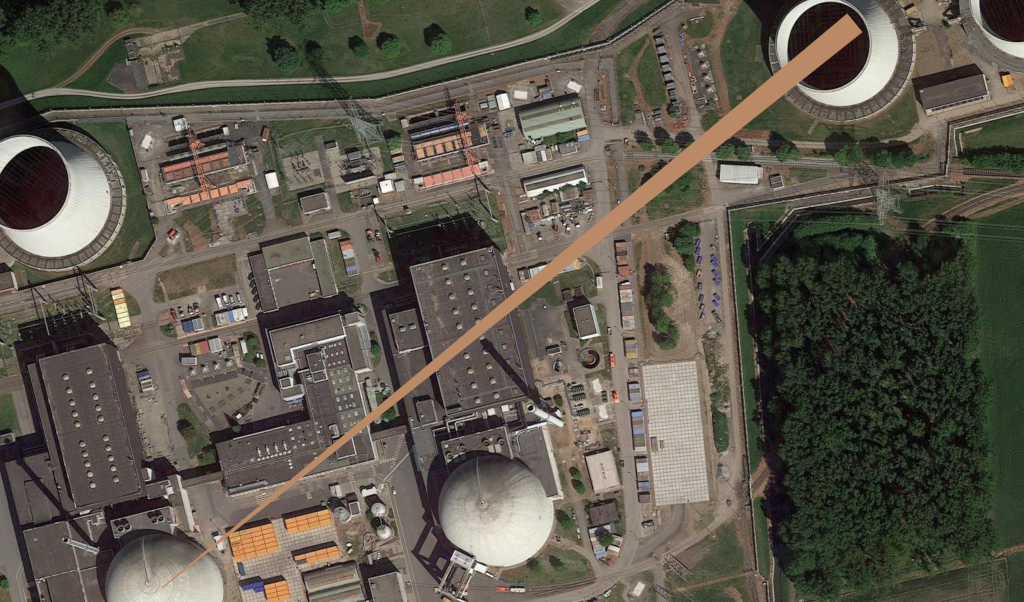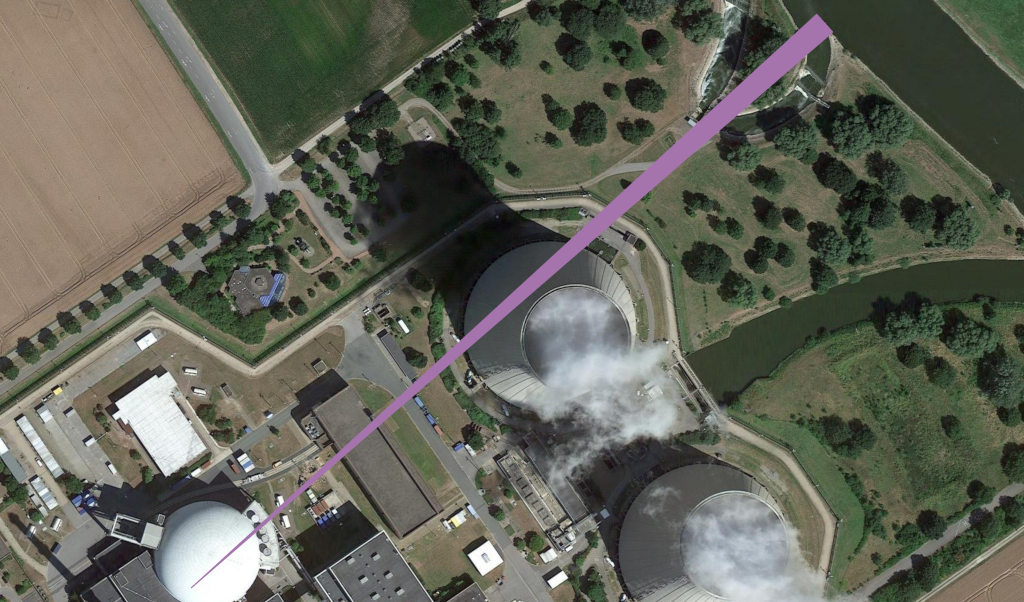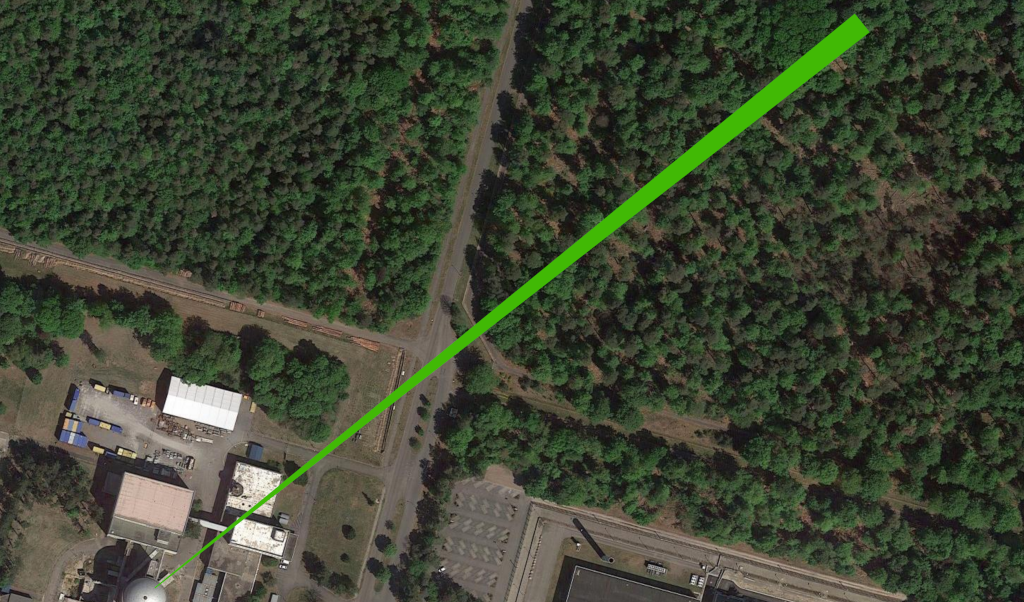10,000 summer solstice sunrises.

[1-BIBLIS-B: https://pris.iaea.org/PRIS/CountryStatistics/ReactorDetails.aspx?current=91]
10,000 summer solstice sunrises charts the alignment of the rising sun on the summer solstice every 100 years over the course of 10,000 years at key human infrastructural locations, such as power stations, nuclear waste dumps and server farms.
10,000 summer solstice sunrises is inspired by the celebrated summer solstice alignment of Stonehenge and the allied practice of archaeoastronomy. The site is aligned in the direction of the sunrise of the summer solstice and the sunset of the winter solstice
The first of the series plots these celestial axes across the 34 sites of nuclear power reactors in Germany.
Each print in this series is now available in a signed edition of 10, archival giclee print on Hahnemuhle Photorag Baryta 315gr. Feel free to DM moi for price, shipping and to assess the full selection of prints in this series.
Software
''' 10,000 summer solstice sunrises charts the alignment of the rising sun on the summer solstice every 10 years over the course of 10,000 years at key human infrastructural locations, such as power stations, nuclear waste dumps and server farms. We need a CSV named places.csv with lines with name, longitude and latitude. VAKKahl am Main, 50.0591294, 8.9871812, BWR, 15, 1960–1985, To open all the CSVs as layers we use this python script in qgis python interpreter box: import os.path, glob layers=[] for file in glob.glob('/root/notes_and_projectsNOW/contiguity_res/software/results/*'): # Change this base path uri = "file:///" + file + "?type=csv&delimiter=%7C&useHeader=No&wktField=field_2&spatialIndex=no&subsetIndex=no&watchFile=no&crs=epsg:4326" vlayer = QgsVectorLayer(uri, os.path.basename(file), "delimitedtext") vlayer.addAttributeAlias(0,'X') vlayer.addAttributeAlias(1,'Y') layers.append(vlayer) QgsMapLayerRegistry.instance().addMapLayers(layers) ''' from datetime import datetime, timedelta from math import pi, degrees, radians from operator import mod import ephem import csv, sys def read_csv_file(filename): data = [] for row in csv.reader(open(filename)): data.append(row) return data def adjust_heading_degrees(alpha): '''add the heading angle to make it between -180 and 180 degrees''' return mod(alpha+180,360)-180 def normalize_vector(x,y,z): '''return a unit normal vector''' length = (x**2+y**2+z**2)**0.5 return x/length, y/length, z/length def calculate_geographic_offset(azimuth_angle,altitude_angle, distance): '''determine the displacement in terms of latitude, longitude, and altitude''' from math import sin, cos, tan, atan2 R = 6371009 # radius of earth in meters dx,dy,dz = normalize_vector( sin(azimuth_angle), cos(azimuth_angle), tan(altitude_angle), ) alpha = atan2(dy,dx) # horizontal angle [radians] D_horiz = distance*(dx**2+dy**2)**0.5 # horizontal length [meters] delta_lat_rad = D_horiz*sin(alpha)/R # latitude offset [radians] delta_lon_rad = D_horiz*cos(alpha)/(R*cos(radians(latitude))) # longitude offset [radians] delta_alt = distance*dz # altitude offset [meters] return delta_lat_rad, delta_lon_rad, delta_alt data=read_csv_file('places.csv') #name, long, lat height = 2 # height of observer [meters] - whether we use height? label_distance = 500 # distance along ephemeris vector [meters] elevation = 2 # elevation above sea level [meters] for row in data: longitude=float(row[2]) ## was reversed latitude=float(row[1]) name=row[0] obs = ephem.Observer() obs.long, obs.lat = str(longitude), str(latitude) obs.elev = elevation + height sun = ephem.Sun() f=open("results/"+name, "w") for i in range(2021, 12021, 100): # 10,000 years of solstice sunrises - every 100 years d1 = ephem.next_solstice(str(i)) obs.date=d1 obs.horizon= '-0.34' sunrise=obs.previous_rising(sun) # this is in UTC obs.date=sunrise sun.compute(obs) delta_lat_rad, delta_lon_rad, delta_alt = calculate_geographic_offset( azimuth_angle=radians(adjust_heading_degrees(degrees(sun.az.real))), altitude_angle=sun.alt.real, distance=label_distance, ) lon = longitude + degrees(delta_lon_rad) lat = latitude + degrees(delta_lat_rad) alt = height + delta_alt sunrise=ephem.Date(sunrise + 2 * ephem.hour) f.write(str(sunrise)+"|LINESTRING("+str(longitude)+" "+str(latitude)+","+str(lon)+" "+str(lat)+")"+"\n") f.close()
Links
https://rhodesmill.org/pyephem/quick.html
https://chrisramsay.co.uk/posts/2017/03/fun-with-the-sun-and-pyephem/
https://pythonhosted.org/pykml/examples/misc_examples.html
https://shallowsky.com/blog/science/astro/astronomical-alignments.html
http://astro.wsu.edu/worthey/astro/html/im-lab/stonehenge/stonehenge.html
https://en.wikipedia.org/wiki/Archaeoastronomy_and_Stonehenge
Further images

[2-KWG-GROHNDE: https://www.preussenelektra.de/de/unsere-kraftwerke/kraftwerkgrohnde.html]

[3-KKII-UNIT1-ESSENBACH: https://www.euronuclear.org/glossary/kki-1/]

[4-MZFR-Leopoldshafen: https://www.atommuellreport.de/daten/detail/mzfr-karlsruhe.html]

[5-KKN-Niederaichbach: https://de.nucleopedia.org/wiki/Kernkraftwerk_Niederaichbach]